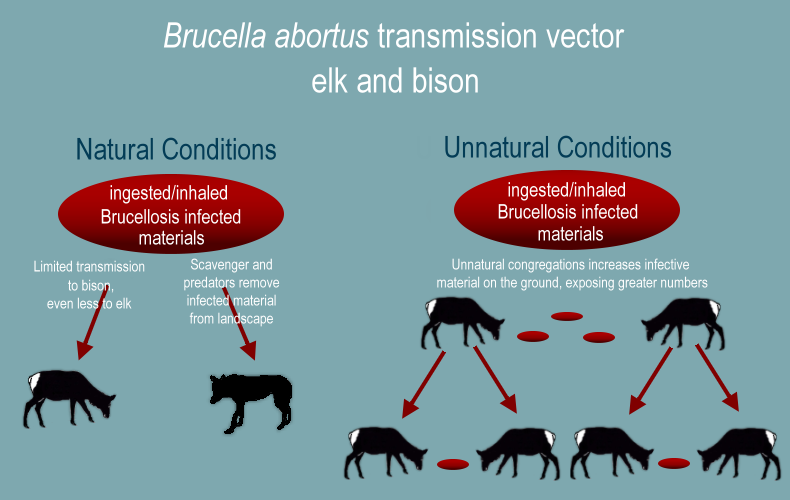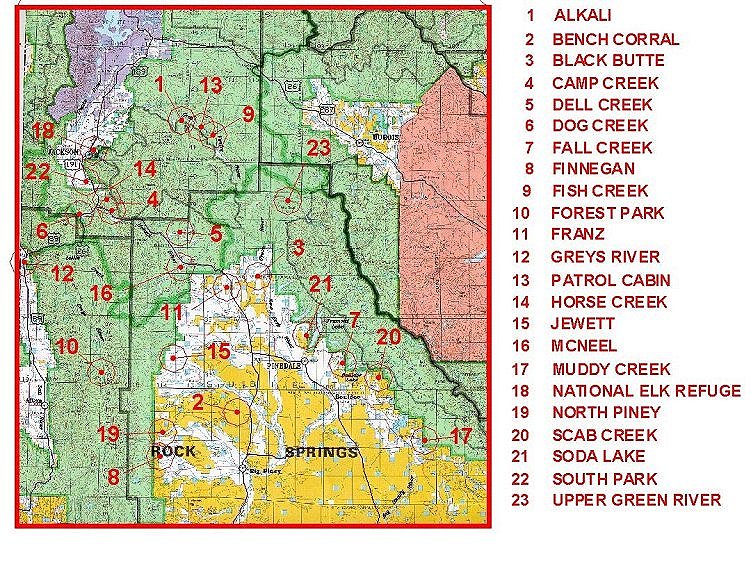Montana's "Brucellosis
Breeding" Wyoming
Feedground
We have
a Wyoming elk feedground situation right here in Gardiner, Montana
that is a major brucellosis threat. Hundreds of bison "gut
piles" from "hunts" concentrated in in a bottle
neck wildlife corridor, within a small acreage of Gardiner, Montana
is spreading brucellosis, threatening our state, the livestock
industry, and the health and social acceptability of our elk,
bison and other ungulate populations. |

|
Most people outside of Wyoming would agree that the 23 elk feedgrounds in Wyoming are disease breeding grounds and need to be closed. They unnaturally congregate elk and are a perfect recipe for diseases, any diseases, to spread from animal to animal. We're talking wildlife here, migratory, free roaming wildlife, not livestock. This is not just a problem for brucellosis, but also Chronic Wasting Disease, also known as CWD which was documented about 5 miles away from the feed grounds this last winter. But this focus is on brucellosis and the Department of Livestocks intentional avoidance of preventing, actually encouraging, of this "elk feedground" situation existing, contrary to their mandate and the laws. Let's look at the basics and break this down into manageable pieces.
How
is brucellosis transmitted?
|

Unnatural
congregations during late winter and spring, involving any infected
animals
It is not just unnatural congregations of wildlife that breed disease, but specifically those where they will be feeding and those that are during the late winter and spring when abortions and birthing materials will be in the congregated areas. This is the brucellosis transmission vector. It is not the feeding or numbers that is causing the brucellosis spread, it is the abortion and birthing materials in an unnaturally congregated area providing the brucellosis transmission vector to be increased to a larger numbers of animals. Click this document for more information on seroprevalence and the difference between seropositive and infected.
|

| Natural elk and bison brucellosis transmission possibilities As shown, the brucellosis transmission vector requires congregations of animals > contacting abortion events or birthing materials, which occur in the late winter to spring > ingesting or inhaling brucellosis infected material. But, under natural conditions the chance of bison brucellosis to transmit to elk, or for elk to elk, is limited. Additionally, natural abortion or birthing materials in the broader landscape are frequently removed by predators, lessening or removing the opportunity of brucellosis transmission to elk and bison.
|
Unnatural concentrations of abortions/possibly infected birthing materials in small area, wildlife corridor, causing increased interspecies brucellosis transmissions - Wyoming Feedground mimicry This unnatural, increased abortion/birthing materials on the landscape in late winter and spring is occurring right here in Montana, just like a Wyoming feed ground, but without the wildlife feeding. This is taking place just north of the Yellowstone National Park in Gardiner, Montana. In the Interagency Bison Management Plans 2008-2009 Annual Report, page 16, it states that utilizing Montana hunters to reduce the numbers of YNP bison that might want to migrate into Montana (a goal of DOL and USDA's APHIS) was not sufficient, because the Montana genreal hunting season occurred before bison were exiting out of the Park and therefore could not be hunted. Montana does not have a bison hunting season that would kill a bison cow in her third trimester when a calf is due to be born. So the IBMP decides to bring in the Native American hunters into the IBMP process and utilize their treaty hunting rights which do not have those prohibitions, hoping to secure greater bison kill numbers. This has increased each year. Last year, in 2013, over 100 bison were killed in a 1/4 mile area just as they exited the YNP by Beatti Gulch. Some were too anxious to shoot and did not wait until they were fully over the line, causing injured bison to fall back into the YNP to die, which could not be retrieved. This is in a residential and commercial area. I will not discuss ethical fair chase hunting here, nor hunting safety of shots in the night or shooting from the road or the private property tresspass. What I want to draw attention to are the hundreds of gut piles, a number of which included nearly born bison calves. Below is a Montana Cadastral image of where the killing took place with small red bison to show approx. locations of bison kills. Not all 100+ are represented by red bison or it would be too crowded. For further details of the 2013 hunt and gut piles, with photo essay, please see the Beatti Gulch Points PDF.
Now the seroprevalence (blood antibodies only) of the YNP bison population is said to be about 50%. Of those that are culture positive, they estimate that to be about 30%. So with 2013's 100+ YNP bison gut piles on the landscape in about a 1/4 mile area, harvested during the third trimester of a bison, when brucellosis is the worst, you are going to have alot of potential infected material lying on the ground. Additionally, this is a bottleneck area that is also a migration corridor for wildlife, meaning as bison and elk come through this corridor the ungulate curiostity will draw them to the gut piles where they naturally sniff, lick, graze on plants with these birthing fluids on the ground. This is the exact scenario of the Wyoming feedgrounds, minus the feeding. Due to landowner complaints, the 2014 hunt was moved a wee bit north of the boundary to avoid the private property tresspass that occurred immediately north of the fence, so it occurred west of the private property around the Old Yellowstone Trail, with over 200 bison killed in this area. They are projecting more next year. The situation on the west side of Yellowstone is a wee bit different, not a bottle neck, more spread out, but still quite a number of bison killed and the resulting gut piles. While the Umatilla were the only tribe to remove the gut piles more into the forest away from the road, that will only address part of the social factor and none of the disease factor. Just for the record, I am an ethical hunter and I respect the Native American rights and their sovereignty. What I am objecting to is an increase in brucellosis on the landscape, infecting our wildlife, making them further socially unacceptable to some and possibly threatening the livestock industry and that backlash against our wildlife. While academic papers speak of abortions and birthing materials on feedgrounds, none of them that I am aware of, have addressed the Native American hunts and these gut piles in the growing seroprevalence in southern Montana. It is being ignored. This increased seroprevalence is going to affect our northern Yellowstone bison and elk populations. While bison are being predominately kept in the YNP, elk are migratory and do come in contact with cattle in the DSA. While the cattle brucellosis infections in Paradise Valley from 2007 forward have been cattle transmissions, not elk, with a Wyoming feedground growing seroprevalence that could grow to 30%, we could begin to see elk transmissions to cattle, which will be a threat to the livestock industry and a threat to our wildlife populations. So why has the DOL and APHIS preferred to whack bison to focus on population reduction while ignoring the brucellosis transmission threat which in contradictory to the twin goals of the IBMP of addressing the risk of brucellosis? Why is the Department of Livestock state veterinarian not managing bison for disease control as stated in 81-2-120 ignoring the threat these gut piles present? We have a Wyoming feedground situation here in Montana, increasing brucellosis and the agencies are ignoring the threat this poses to Montana. |
Your Advertisement Here |
Site designed and maintained by Kathryn QannaYahu








